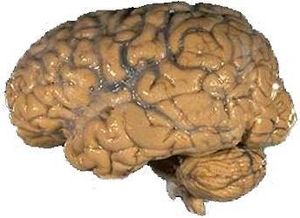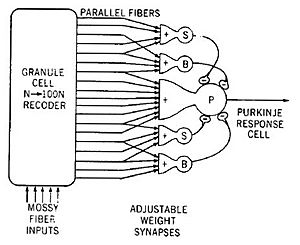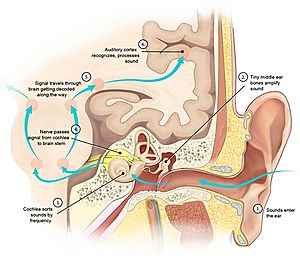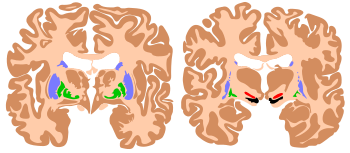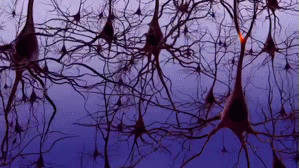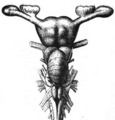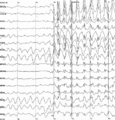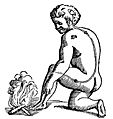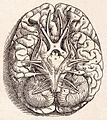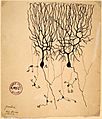Brain facts for kids
The brain is an amazing organ inside your head that helps you and other animals understand the world. It takes in information from your senses (like sight, sound, smell, taste, and touch). Then, it helps you react to that information. For humans, the brain also lets us use language and think about big, complex ideas. It's like the control center for your whole body!
Your brain is made of special tiny parts called cells. These cells are connected to each other and to the nerves all over your body. The brain is very delicate, so it's protected. In humans and other animals with backbones (called vertebrates), the brain is safely tucked inside the bones of your skull.
What the Brain Does
Your brain is busy all the time! It's where you do all your thinking, learning new things, and feeling emotions. For humans, it's also where our consciousness (being aware of ourselves) comes from.
The brain also handles many things automatically, without you even thinking about them. These are called autonomic actions. For example, your brain controls your breathing, how your body digests food, and your heartbeat. All the information your senses gather – what you see, hear, smell, taste, and feel – travels through nerves to your brain. Your brain then processes this information, so you experience it as pictures, sounds, and so on. The brain also uses nerves to tell your body what to do, like telling your muscles to move or your heart to beat faster.
Most animals with backbones have brains, and over time, these brains have become more complex. But some simple animals, like sponges, don't have anything like a brain. Other animals, like worms, have simpler nerve bundles called ganglions that help them react to their surroundings.
How We Sense the World
Your human brain gets lots of information! It knows about light, sound, smells in the air, temperature, which way your head is pointing, where your arms and legs are, and even what's in your blood. Some animals have extra senses. Snakes can feel heat, some birds can sense magnetic fields, and some fish can sense electric fields!
Every sense starts with special cells that pick up information. These cells then send signals to your brain.
Controlling Movement
The brain has special areas that help you move your body. These areas tell your muscles when and how to move. Most of the muscles you control (like those in your arms and legs) are directly connected to nerves in your spinal cord and lower brain.
Your brain has different levels of control for movement. Lower parts of the brain control automatic movements like walking or breathing. Higher up, areas like the red nucleus help coordinate arm and leg movements. The primary motor cortex, a strip at the front of your brain, sends direct signals to your spinal cord. This allows you to make very precise movements, like writing or playing an instrument. Other brain areas, like the premotor cortex, basal ganglia, and cerebellum, also help by working with these main motor areas.
The brain and spinal cord also control your autonomic nervous system, which manages things like digestion and heart rate by releasing chemicals and controlling smooth muscles.
Sleep and Being Awake
Many animals, including humans, switch between sleeping and being awake each day. How awake and alert you feel is controlled by a network of brain areas.
A key part of this system is the suprachiasmatic nucleus (SCN). It's a tiny part of your brain that acts like your body's main biological clock. The cells here have activity levels that go up and down over about 24 hours. This is why you have a circadian rhythm (your natural sleep-wake cycle). The SCN gets signals from your eyes, which helps it adjust to the daily light and dark.
The SCN sends signals to other brain areas that help control sleep and wakefulness. An important part is the reticular formation, which sends signals to many parts of your brain to control how active they are. If this area is damaged, a person can fall into a permanent coma.
When you sleep, your brain activity changes a lot!
Keeping Your Body Balanced

For any animal to survive, its body needs to keep many things stable, like temperature, water levels, salt in the blood, and blood sugar. This ability to keep the body's internal environment stable is called homeostasis.
Keeping your body balanced is a super important job for your brain. It works like a negative feedback system. Imagine a thermostat in your house: if the temperature gets too cold, it turns on the heat. If it gets too hot, it turns off the heat. Your brain does something similar. If something in your body goes off track, sensors send a signal, and your brain makes a change to bring it back to normal.
In animals with backbones, the hypothalamus plays the biggest role in homeostasis. It's a small area at the base of your brain, but it's very important. It has many tiny parts that control basic body functions, including keeping your body balanced.
What Makes Us Act
Animals need to do things that help them survive, like finding food, water, shelter, and a mate. The brain's motivation system checks if these needs are met. If not, it makes you want to do things to meet them. This system often works using rewards and punishments.
When you do something that has good results, your brain's reward system is activated. This makes changes in your brain that encourage you to repeat that behavior later if a similar situation happens. On the other hand, if a behavior has bad results, your brain's punishment system is activated. This makes changes that stop you from doing that behavior again in similar situations.
Most animals use this reward-punishment system. In animals with backbones, the basal ganglia are key to this system. They are a group of connected areas at the base of your brain.
The basal ganglia are central to making decisions. They usually keep your motor systems (the parts that control movement) "on hold." When the basal ganglia release this hold, a motor system is allowed to carry out an action. Rewards and punishments change how the basal ganglia work, influencing the decisions they make.
Learning and Remembering
Almost all animals can change their behavior based on what they've experienced, even very simple worms. Since behavior comes from brain activity, these changes must mean something changes inside the brain. Scientists like Santiago Ramón y Cajal thought that learning and memory happen because the connections between brain cells (called synapses) change.
Later, in 1971, Tim Bliss and Terje Lømo found strong evidence for this idea. They showed that brain cell connections could change and stay changed for days. Since then, many studies have shown how these changes happen in different parts of the brain. Things like brain-derived neurotrophic factor (BDNF) and physical activity seem to help with this process.
Scientists now understand that there are different types of learning and memory:
- Working memory is like your brain's temporary notepad. It helps you hold information you need for a task right now, like remembering a phone number while you dial it.
- Episodic memory is your ability to remember specific events, like what you had for breakfast or your last birthday party. These memories can last your whole life. The hippocampus part of your brain is very important for this. If it's damaged, people might have amnesia and can't form new long-lasting memories.
- Semantic memory is your ability to learn facts and general knowledge, like knowing that Paris is the capital of France. This type of memory is likely stored in the outer layer of your brain, the cerebral cortex.
- Instrumental learning is when rewards and punishments change your behavior. This is handled by brain areas centered around the basal ganglia.
- Motor learning is when you get better at physical movements by practicing, like learning to ride a bike or play a sport. Many brain areas are involved, especially the cerebellum, which helps fine-tune your movements.
Parts of the Brain
In mammals, like humans, the brain has three main parts: the cerebrum, the cerebellum, and the brainstem. The outer surface of the cerebrum is called the cerebral cortex. Mammals have an extra layer of cortex called the neocortex. This part is key to how mammals, especially humans, behave.
The Cerebrum (Cerebral Cortex)
The cerebral cortex is the largest part of your brain. It has areas for your senses, areas for movement, and "association" areas.
- The sensory areas receive and process information from your senses.
- The motor areas control your voluntary movements, especially precise hand movements. Interestingly, the right side of your motor area controls the left side of your body, and vice versa!
- The association areas help you make sense of the world, think abstractly, and use language. These areas help us interact effectively with others.
The Cerebellum
The cerebellum is located at the back of your brain, under the cerebrum. Its main job is to coordinate your muscles so they work smoothly together. It's also vital for your balance, which is super important for all movement.
The Brain Stem
The brain stem connects the rest of your brain to your spinal cord. It's packed with different parts that control many essential body functions you don't even think about. For example, the brain stem controls your breathing, heartbeat, sneezing, eye blinking, and swallowing. It also helps control your body temperature and hunger.
Brain Size
The human brain is very large compared to the size of our whole body, especially when you compare it to most other animals. The human brain also has a very wrinkled surface (the cortex). If you could flatten out the human cortex, it would be almost a square meter in area! Some other animals, like dolphins and elephants, also have very wrinkled brains.
A general rule is that larger animals tend to have larger brains. But even considering that, the human brain, especially the neocortex, is unusually big. We know it grew four times larger over the last few million years of evolution. Scientists have ideas about why this happened, but no one is completely sure. Most theories suggest that complex social activities and the development of language made a larger brain very helpful.
It's interesting to note that Albert Einstein's brain weighed only 1,230 grams, which is less than the average adult male brain (about 1,400 grams). This shows that the detailed organization of a brain matters a lot, even if we don't fully understand how yet.
Brain Cells: Neurons and Glia
Your brain makes up about 2% of your body's weight, but it uses about 20% of your body's energy! It has about 50 to 100 billion nerve cells, called neurons. It also has roughly the same number of support cells, called glia.
Neurons are the main workers; their job is to receive and send information to and from the rest of your body. Glia are like the support crew; they provide nutrients and guide blood flow to the neurons, helping them do their job. Each neuron can connect with as many as 10,000 other neurons through tiny connections called synapses.
Related pages
Images for kids
-
Neurons create electrical signals that travel along their axons. When a signal reaches a connection called a synapse, it releases a chemical that affects other cells' electrical activity.
-
Drosophila (fruit flies) are studied to understand how genes affect brain development.
-
The brain of a shark.
-
Brain electrical activity recorded from a human patient during an epileptic seizure.
-
An illustration by René Descartes showing how the brain might create a reflex action.
-
A drawing from Andreas Vesalius' book Fabrica (1543), showing the base of the human brain.
-
A drawing by Santiago Ramón y Cajal of two types of brain cells (neurons) from a pigeon's cerebellum.
-
Gulai otak, a beef brain curry from Indonesia.
See also
 In Spanish: Cerebro para niños
In Spanish: Cerebro para niños


